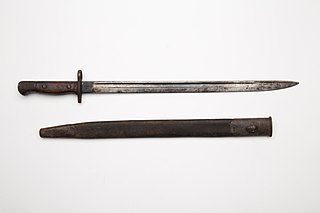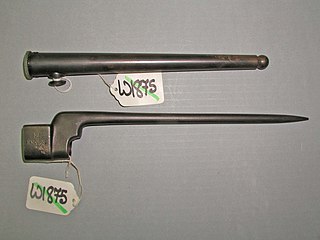
A carbine is a long gun that has a barrel shortened from its original length. Most modern carbines are rifles that are compact versions of a longer rifle or are rifles chambered for less powerful cartridges.

The SA80 is a British family of 5.56×45mm NATO service weapons used by the British Army. The L85 Rifle variant has been the standard issue service rifle of the British Armed Forces since 1987, replacing the L1A1 Self-Loading Rifle. The prototypes were created in 1976, with production of the A1 variant starting in 1985 and ending in 1994. The A2 variant came to be as the result of a significant upgrade in the early 2000s by Heckler & Koch and remains in service as of 2023. The A3 variant was first issued in 2018 with several new improvements.

The Lee–Enfield or Enfield is a bolt-action, magazine-fed repeating rifle that served as the main firearm of the military forces of the British Empire and Commonwealth during the first half of the 20th century, and was the British Army's standard rifle from its official adoption in 1895 until 1957. The WWI versions are often referred to as the SMLE, which is short for the common "Short, Magazine, Lee–Enfield" variant.
The Rifle No. 5 Mk I, nicknamed the "Jungle Carbine" for its use in jungle warfare, was a bolt action carbine derivative of the British Lee–Enfield No. 4 Mk I. It was developed per jungle fighting experiences in the Pacific War that led the British to decide "a rifle shorter and lighter" than the regular Lee–Enfield was critical for better mobility. Produced between March 1944 and December 1947, the Jungle Carbine was intended for and used in jungle environments where it gained its nickname. It notably saw widespread usage in on various sides of various postwar colonial conflicts such as the Indonesian National Revolution, Malayan Emergency, and Vietnam War well into the 1960s, with sporadic use reported to have continued in several secessionist wars such as the Bangladesh Liberation War and Bougainville conflict throughout the rest of the 20th century.
The Lanchester is a submachine gun manufactured by the Sterling Armaments Company between 1941 and 1945. it is an evolution from MP28/II and was manufactured in two versions, Mk.1 and Mk.1*; the latter was a simplified version of the original Mk.1, with no fire selector and simplified sights. It was primarily used by the Royal Navy during the Second World War, and to a lesser extent by the Royal Air Force Regiment. It was given the general designation of Lanchester after George Lanchester, who was charged with producing the weapon at the Sterling Armaments Company.

The Webley Revolver was, in various designations, a standard issue service pistol for the armed forces of the United Kingdom, and countries of the British Empire and the Commonwealth of Nations, from 1887 to 1970.

The Martini–Henry is a breech-loading single-shot rifle with a lever action that was used by the British Army. It first entered service in 1871, eventually replacing the Snider–Enfield, a muzzle-loader converted to the cartridge system. Martini–Henry variants were used throughout the British Empire for 47 years. It combined the dropping-block action first developed by Henry O. Peabody and improved by the Swiss designer Friedrich von Martini, combined with the polygonal rifling designed by Scotsman Alexander Henry.

A fuller is a rounded or beveled longitudinal groove or slot along the flat side of a blade that serves to both lighten and stiffen the blade, when considering its reduced weight. However, cutting or grinding a fuller into an existing blade will decrease its absolute stiffness by a small amount due to the removal of material, but much of the strength remains due to the geometry of its shape. When the groove is forged into the blade, it achieves a similar reduction in weight with a relatively small reduction in strength without the wasted material produced by grinding (kerf). When forged, it is made using a blacksmithing tool that is also called a fuller, a form of a spring swage, or impressed during forging. When combined with proper distal tapers, heat treatment and blade tempering, a fullered blade can be 20% to 35% lighter than a non-fullered blade. The ridges and groove created by the fuller are comparable to an I-beam's flanges and web; this shape aims to optimize the strength and stiffness for a given quantity of material, particularly in the cutting direction.

The M1917 Enfield, the "American Enfield", formally named "United States Rifle, cal .30, Model of 1917" is an American modification and production of the .303-inch Pattern 1914 Enfield (P14) rifle, which was developed and manufactured during the period 1917–1918. Numerically, it was the main rifle used by the American Expeditionary Forces in Europe during World War I. The Danish Sirius Dog Sled Patrol on Greenland still use the M1917, which performs reliably in Arctic conditions, as their service weapon.

The origins of the modern British military rifle are within its predecessor the Brown Bess musket. While a musket was largely inaccurate over 100 yards (91 m), due to a lack of rifling and a generous tolerance to allow for muzzle-loading, it was cheap to produce and could be loaded quickly. The use of volley or mass firing by troops meant that the rate of fire took precedence over accuracy.
The Rifle 7.62mm 2A/2A1 is a 7.62×51mm NATO calibre bolt-action rifle adopted as a reserve arm by the Indian Armed Forces in 1963. The rifle is a variant of the Lee–Enfield rifle. The design of the rifle – initially the Rifle 7.62mm 2A – began at the Rifle Factory Ishapore of the Ordnance Factories Board in India, soon after the Sino-Indian War of 1962.

The FÉG 35M was a bolt-action rifle, chambered in 8×56mmR. Though superficially still resembling the 95/31M Carbine it was a new design with a cock-on-close bolt. An easily recognizable distinguishing feature was the placement of the bolt handle, which was further forward than in the 1895 design. It was used by Hungary in the years leading up to and during World War II, and after World War II before being gradually phased out by both Red Army surplus and locally produced Mosin–Nagant carbines.

"Swedish Mausers" are a family of bolt-action rifles based on an improved variant of Mauser's earlier Model 1893, but using the 6.5×55mm Swedish cartridge, and incorporating unique design elements as requested by Sweden. These are the m/94 carbine, m/96 long rifle, m/38 short rifle and m/41 sniper rifle. Production began in 1898 at Carl Gustafs stads Gevärsfaktori in Eskilstuna, Sweden.

The Pattern 1907 bayonet, officially called the Sword bayonet, pattern 1907 , is an out-of-production British bayonet designed to be used with the Short Magazine Lee Enfield (SMLE) rifle. The Pattern 1907 bayonet was used by the British and Commonwealth forces throughout both the First and Second World Wars.

The No. 4 Bayonet was the standard bayonet for all Lee Enfield No 4 rifles.

The Sten bayonet Mark I was the standard bayonet for the Sten mk II submachine gun. Most of the bayonets were disposed of making originals extremely rare.
The No. 7 Bayonet was a bayonet primarily used with the Sten Mk V submachine gun. However, it could be used on the No. 4 Lee-Enfield, but only for ceremonial purposes as the bayonet obstructed the path of the .303 round fired from the gun.













